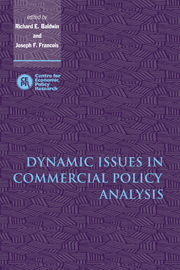Book contents
- Frontmatter
- Contents
- List of figures
- List of tables
- Preface
- List of conference participants
- 1 Introduction
- 2 Transition dynamics and trade policy reform in developing countries
- 3 Putting growth effects in computable equilibrium trade models
- 4 Innovation, capital accumulation, and economic transition
- 5 Multinational production, skilled labour, and real wages
- 6 Economic policy and the manufacturing base: hysteresis in location
- 7 Trade liberalization and investment in a multilateral framework
- 8 Investment creation and investment diversion: simulation analysis of the Single Market programme
- 9 Blueprints, spillovers, and the dynamic gains from trade liberalization in a small open economy
- 10 Trade policy and North–South migration
- 11 Long-term modelling of trade and environmental linkages
- 12 Labour markets and dynamic comparative advantage
- Index
7 - Trade liberalization and investment in a multilateral framework
Published online by Cambridge University Press: 13 January 2010
- Frontmatter
- Contents
- List of figures
- List of tables
- Preface
- List of conference participants
- 1 Introduction
- 2 Transition dynamics and trade policy reform in developing countries
- 3 Putting growth effects in computable equilibrium trade models
- 4 Innovation, capital accumulation, and economic transition
- 5 Multinational production, skilled labour, and real wages
- 6 Economic policy and the manufacturing base: hysteresis in location
- 7 Trade liberalization and investment in a multilateral framework
- 8 Investment creation and investment diversion: simulation analysis of the Single Market programme
- 9 Blueprints, spillovers, and the dynamic gains from trade liberalization in a small open economy
- 10 Trade policy and North–South migration
- 11 Long-term modelling of trade and environmental linkages
- 12 Labour markets and dynamic comparative advantage
- Index
Summary
Introduction
The gains from trade in static models stem from the increased efficiency of resource allocation and improved consumption possibilities. With the addition of imperfect competition, gains from trade may also follow from pro-competitive effects related to increasing returns to scale, the erosion of market power, and increased product and input variety. Numerical estimates of basic static efficiency effects tend to be relatively small as a percentage of gross domestic product (GDP). For example, static assessments of the Tokyo Round and Uruguay Round typically pointed to income effects of less than 1 per cent of base GDP. This is hardly consistent with cross-country studies of trade and income, which suggest linkages between trade policy and incomes, through investment, much stronger than those identified in static numeric studies. Nor are such modest estimates easily reconciled with the expectations held about trade reforms of this magnitude.
One shortcoming of the basic static story is that it fails to account for the positive relationship between trade, investment, and growth, a linkage that is fairly well established empirically (see, e.g., Edwards (1992), and Levine and Renelt (1992)). Also, on a theoretical level, classical growth theory suggests the potential for a medium-run growth or accumulation effect through induced changes in savings and investment patterns. The magnitude and possible direction of such effects depend on whether savings are assumed to be exogenously fixed or endogenously derived from intertemporal optimization.
On the basis of this literature, we explore the interaction between trade policy and capital accumulation in a multi-sector, multi-country setting. The trade policy reforms considered are the basic elements of the Uruguay Round.
- Type
- Chapter
- Information
- Dynamic Issues in Commercial Policy Analysis , pp. 202 - 227Publisher: Cambridge University PressPrint publication year: 1999
- 4
- Cited by



